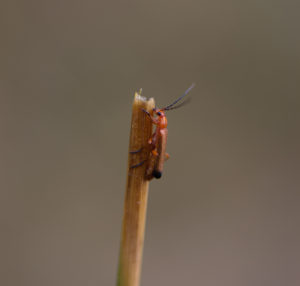 The common name comes from the fact that the larvae bore into wharf pilings, both in sea water and fresh water. Adults are nuisance pests, especially when they suddenly appear in large numbers. This species is distributed worldwide.
The common name comes from the fact that the larvae bore into wharf pilings, both in sea water and fresh water. Adults are nuisance pests, especially when they suddenly appear in large numbers. This species is distributed worldwide.
Adults are about about 1/4-9/16″ (7-14 mm) long; body elongate, slender, and soft. Color of dorsum pale brownish/reddish yellow with elytral tips and sometimes pronotal sides blackish, eyes and venter black, antenna pale, and legs mostly dark.
The larvae typically bore in very moist wood in which fungal decay has already started. They do not bore a system of tunnels and galleries, but instead tend to work in rather indeterminate spaces which are plugged here and there with long torn wood fibers. These boring spaces are often adjacent to sound wood. The wood area being attacked cannot have a wood moisture content much above the fiber saturation point of about 30%. Larvae can significantly accelerate the destruction of wood already attacked by fungal decay. Typically the first visible sign of infestation is the appearance of numerous adults. Quite often the infested wood is buried and not accessible.
Little has been published on the biology of this species other than the information given in the Damage and Signs_of Infestation and Habits sections; descriptions of the larva and pupa have been published.
Wharf borers attack mainly softwoods but occasionally oak and other hardwoods are infested. This wood must be damp or wet and fungal decay must already have started. The moisture can come from either sea water or fresh water.
Around structures, wharf borers may occur in decaying moist wood found in foundation pilings under buildings, in damp basements and/or crawl spaces, wood around leaky plumbing, in buried wood, and in wood with ground contact such as old form boards and support posts.
If possible, correct the excessive moisture conditions and remove all woodto-ground contact, cellulose debris, and buried wood associated with structures. Spot treatment of non-removable buried wood with a pesticide labeled for wood-destroying insects may be helpful. Seal all possible entrances to problem rooms at the ground level. Remove the adults with a vacuum.
Around docks and wharfs, replace decaying wood with pressure-treated wood. For water craft, replace the decaying wood and increase the frequency of hull inspection/maintenance.
